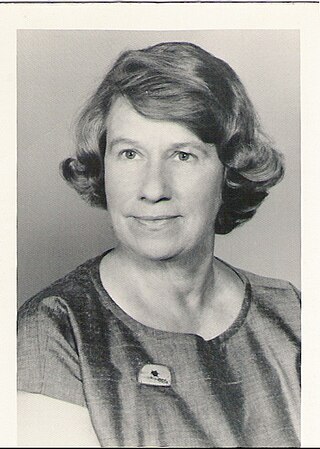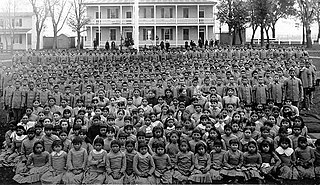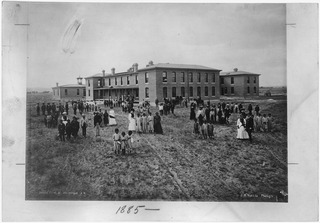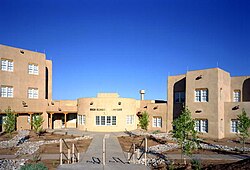
The Hopi are Native Americans who primarily live in the southwestern United States. The majority are enrolled in the Hopi Tribe of Arizona and live on the Hopi Reservation in northeastern Arizona; however, some Hopi people are enrolled in the Colorado River Indian Tribes of the Colorado River Indian Reservation at the border of Arizona and California.

Kewa Pueblo is a federally-recognized tribe of Native American Pueblo people in northern New Mexico, in Sandoval County southwest of Santa Fe. The pueblo is recorded as the Santo Domingo Pueblo census-designated place by the U.S. Census Bureau, with a population of 2,456 at the 2010 census.

The Tewa are a linguistic group of Pueblo Native Americans who speak the Tewa language and share the Pueblo culture. Their homelands are on or near the Rio Grande in New Mexico north of Santa Fe. They comprise the following communities:

The United States Indian Industrial School in Carlisle, Pennsylvania, generally known as Carlisle Indian Industrial School, was the flagship Indian boarding school in the United States from its founding in 1879 through 1918. It took over the historic Carlisle Barracks, which was transferred to the Department of Interior from the War Department. After the United States entry into World War I, the school was closed and this property was transferred back for use by the Department of Defense. All the property is now part of the U.S. Army War College.

The Institute of American Indian Arts (IAIA) is a public tribal land-grant college in Santa Fe, New Mexico, United States. The college focuses on Native American art. It operates the Museum of Contemporary Native Arts (MoCNA), which is housed in the historic Santa Fe Federal Building, a landmark Pueblo Revival building listed on the National Register of Historic Places as Federal Building. The museum houses the National Collection of Contemporary Indian Art, with more than 7,000 items.

Dorothy Dunn Kramer was an American art instructor who created The Studio School at the Santa Fe Indian School.

Esther Martinez also known as Estefanita Martinez was a linguist and storyteller for the Tewa people of New Mexico. Martinez was given the Tewa name P’oe Tsáwä and was also known by various affectionate names, including "Ko'oe Esther" and "Aunt Esther."

Sherman Indian High School (SIHS) is an off-reservation boarding high school for Native Americans. Originally opened in 1892 as the Perris Indian School, in Perris, California, the school was relocated to Riverside, California, in 1903, under the name Sherman Institute. When the school was accredited by the Western Association of Schools and Colleges in 1971, it became known as Sherman Indian High School.
The Native American Preparatory School Inc. (NAPS) was a residential university preparatory school located in unincorporated San Miguel County, New Mexico, in proximity to South San Ysidro. The school had a Rowe PO Box. The school's website also listed an office in Santa Fe.

The School for Advanced Research (SAR), until 2007 known as the School of American Research and founded in 1907 as the School for American Archaeology (SAA), is an advanced research center located in Santa Fe, New Mexico, U.S. Since 1967, the scope of the school's activities has embraced a global perspective through programs to encourage advanced scholarship in anthropology and related social science disciplines and the humanities, and to facilitate the work of Native American scholars and artists. SAR offers residential fellowships for artists and scholars, and it publishes academic and popular non-fiction books through SAR Press.

American Indian boarding schools, also known more recently as American Indian residential schools, were established in the United States from the mid-17th to the early 20th centuries with a primary objective of "civilizing" or assimilating Native American children and youth into European American culture. In the process, these schools denigrated Native American culture and made children give up their languages and religion. At the same time the schools provided a basic Western education. These boarding schools were first established by Christian missionaries of various denominations. The missionaries were often approved by the federal government to start both missions and schools on reservations, especially in the lightly populated areas of the West. In the late 19th and early 20th centuries especially, the government paid religious orders to provide basic education to Native American children on reservations, and later established its own schools on reservations. The Bureau of Indian Affairs (BIA) also founded additional off-reservation boarding schools based on the assimilation model. These sometimes drew children from a variety of tribes. In addition, religious orders established off-reservation schools.
The Harvard Project on American Indian Economic Development, also known as the Harvard Project, was founded in 1987 at Harvard Kennedy School at Harvard University. It administers tribal awards programs as well as provides support for students and conducting research. The Harvard Project aims to understand and foster the conditions under which sustained, self-determined social and economic development is achieved among American Indian nations through applied research and service.

The Bureau of Indian Education (BIE), headquartered in the Main Interior Building in Washington, D.C., and formerly known as the Office of Indian Education Programs (OIEP), is a division of the U.S. Department of the Interior under the Assistant Secretary for Indian Affairs. It is responsible for the line direction and management of all BIE education functions, including the formation of policies and procedures, the supervision of all program activities, and the approval of the expenditure of funds appropriated for BIE education functions.

The Native American Languages Act of 1990 is the short cited title for executive order PUBLIC LAW 101-477 enacted by the United States Congress on October 30, 1990. Public Law 101-477 of 1990 gave historical importance as repudiating past policies of eradicating Indian Languages by declaring as policy that Native Americans were entitled to use their own languages. The fundamental basis of the policy's declaration was that the United States "declares to preserve, protect and promote the rights and freedom of Native Americans to use practice and develop Native American Languages".
The Paolo Soleri Amphitheater is an amphitheater in Santa Fe, New Mexico, which opened in 1970 and closed in 2010. The structure, which was never considered finished, was designed by Italian architect Paolo Soleri.

Tonita Peña born as Quah Ah but also used the name Tonita Vigil Peña and María Antonia Tonita Peña. Peña was a renowned Pueblo artist, specializing in pen and ink on paper embellished with watercolor. She was a well-known and influential Native American artist and art teacher of the early 1920s and 1930s.

The Employees' New Dormitory and Club, also known as Building 232, is a historic building in Albuquerque, New Mexico. Built in 1931, it is notable as the only surviving building of the Albuquerque Indian School, which operated at this location from 1882 to 1976. It was added to the New Mexico State Register of Cultural Properties in 1981 and the National Register of Historic Places in 1982.

Elizabeth Willis DeHuff (1886–1983) was an American painter, teacher, playwright, and children's book writer. She was an important contributor to the development of Native American easel painting in the 1920s and 1930s. DeHuff is also a children's book author who writes predominantly utilizing Native American folklore and themes. Among these books are Blue-Wings-Flying and TayTay's Tales. In writing these children's books, and other works by her like Kaw-eh and Say the Bells of Old Missions: Legends of Old New Mexico Churches that are not necessarily children's books, DeHuff is instrumental in documenting Native American folklore and providing authenticity in the telling of it. Overall, she wrote 65 works in 118 publications. These other works included non children's books and periodical articles Native American, Hispanic, and New Mexico subjects.

Albuquerque Indian School (AIS) was a Native American boarding school in Albuquerque, New Mexico, which operated from 1881 to 1981. It was one of the oldest and largest off-reservation boarding schools in the United States. For most of its history it was run by the Bureau of Indian Affairs (BIA). Like other government boarding schools, AIS was modeled after the Carlisle Indian Industrial School, using strict military-style discipline to strip students of their native identity and assimilate them into white American culture. The curriculum focused on literacy and vocational skills, with field work components on farms or railroads for boys and as domestic help for girls. In the 1930s, as the philosophy around Indian education changed, the school shifted away from the military approach and offered more training in traditional crafts like pottery, weaving, and silversmithing.
Pine Hill Schools is a K-12 tribal school system operated by the Ramah Navajo School Board, Inc. (RNSB), in association with the Bureau of Indian Education (BIE), in Pine Hill, New Mexico.


















